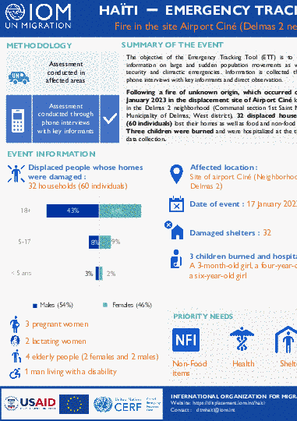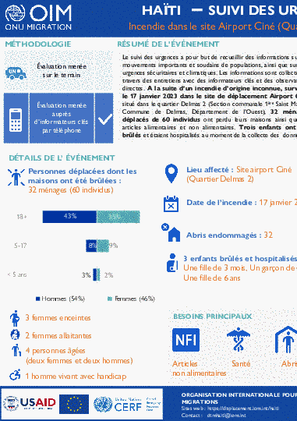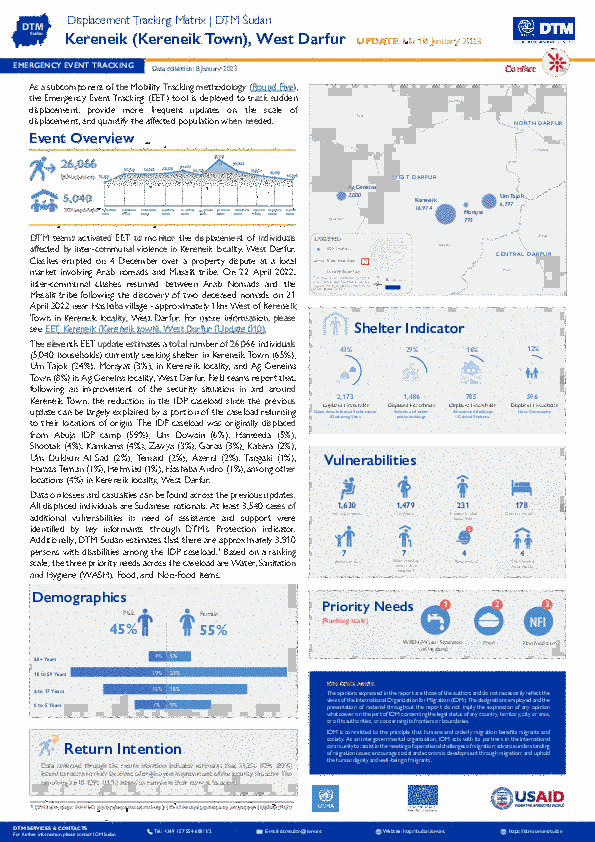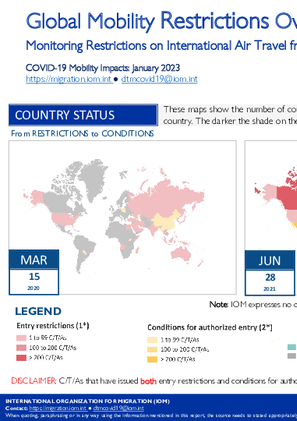-
Countries
-
Data and Analysis
-
Special Focus
-
Crisis Responses

Contact
dtmhaiti@iom.int
Language
English
Location
Haiti
Period Covered
Jan 17 2023
Jan 17 2023
Activity
- Event Tracking
The objective of the Emergency Tracking Tool (is to collect information on large and sudden population movements as well as
security and climactic emergencies. Information is collected through phone interviews with key informants and direct observation.
Following a fire of unknown origin, which occurred on 17 January 2023 in the displacement site of Airport Ciné located
in the Delmas 2 neighborhood (Communal section 1 st Saint Martin, Municipality of Delmas, West district), 32 displaced households (60 individuals) lost their homes as well as food and non food items. Three children were burned and were hospitalized at the time of data collection.

Contact
dtmhaiti@iom.int
Language
French
Location
Haiti
Period Covered
Jan 17 2023
Jan 17 2023
Activity
- Event Tracking
Le suivi des urgences a pour but de recueillir des informations sur les mouvements importants et soudains de populations, ainsi que sur des urgences sécuritaires et climatiques. Les informations sont collectées à travers des entretiens avec des informateurs clés et des observations directes.
A la suite d’un incendie d’origine inconnue, survenu le 1 7 janvier 2023 dans le site de déplacement Airport Ciné situé dans le quartier Delmas 2 (Section communale 1 ère Saint Martin, Commune de Delmas, Département de l’Ouest), 32 ménages déplacés de 60 individus ont perdu leurs maisons ainsi que les articles alimentaires et non alimentaires. Trois enfants ont été
brûlés et étaient hospitalisés au moment de la collecte des données.

Contact
DTM Europe, DTMMediterranean@iom.int
Language
English
Location
Republic of Moldova
Period Covered
Apr 16 2022
Nov 18 2022
Activity
- Survey
- Return Intention
Since 24 February 2022, Ukrainians and Third-Country Nationals (TCNs) have been fleeing from Ukraine to neighbouring
countries as a result of the war in Ukraine. According to the Moldovan General Inspectorate for Border Police, as of 20th
November, a total of 698,131 refugees from Ukraine and TCNs were registered at border crossing points (BCPs) while
entering from Ukraine into the Republic of Moldova. At the same time, movements of persons crossing back to Ukraine
have also been reported. According to the same source, 370,918 Ukrainian nationals and TCNs, who entered into the
Republic of Moldova, from all border control points since 24 February 2022, have exited back to Ukraine (Source: General
Inspectorate for Border Police).
Since April 2022, the International Organization for Migration (IOM) has conducted surveys with adults (18 years and above)
crossing back to Ukraine, through CBS Axa Research. The crossing back survey is part of IOM’s DTM activities that are
meant to monitor the displacement patterns, movement flows and intentions, regions of origin, and most immediate needs
of refugees from Ukraine and TCNs who fled from Ukraine into neighbouring countries and other European countries since
24 February 2022 and are crossing back into Ukraine.
This report presents an analysis of the evolution of respondents’ sociodemographic profiles, travel characteristics, regions of
origin, humanitarian needs and intentions over time, during the covered period of 16 April and 18 November. During this
period, 6 173 individuals were interviewed, most of whom were Ukrainian citizens (95%) while three per cent were TCNs
and two per cent were Moldovan nationals. Data was collected at three main BCPs from the Republic of Moldova to
Ukraine: at Otaci BCP (45%), at Palanca BCP and Transit centre (50%), at Tudora BCP (4%). Individuals crossing into
Ukraine are not necessarily returnees and the sample is not representative of all persons crossing into Ukraine, results
should hence only be considered as indicative.

Contact
DTM Sudan; dtmsudan@iom.int
Language
English
Location
Sudan
Snapshot Date
Jan 08 2023
Activity
- Mobility Tracking
- Event Tracking
The DTM Emergency Event Tracking (EET) is deployed to track sudden displacement and population movements, provide more frequent updates on the scale of displacement, and quantify the affected population when needed. As a subcomponent of the new Mobility Tracking methodology in Sudan (Round Five), and activated on a need basis, EET utilises a broad network of key informants to capture best estimates of the affected population presence per location – a useful tool for humanitarian response planning and design.

Contact
DTM Cameroon, DTMCameroon@iom.int
Language
English
Location
Cameroon
Period Covered
Aug 11 2022
Aug 24 2022
Activity
- Mobility Tracking
- Baseline Assessment
Ce rapport présente un aperçu de la situation de déplacement dans les localités accueillant les populations mobiles (Personnes déplacées internes ( personnes retournées et les réfugiés hors camp) dans la région de l’Extrême Nord du Cameroun ayant effectué soit des mouvements de déplacements forcés, soit des mouvements de retour dans leurs localités de provenance L’évaluation a été réalisée par l’Organisation Internationale pour les Migrations (entre le 11 et le 24 août 2022 dans 1 092 localités d’accueil des PDI, des retournés et des réfugiés hors camp et 99 sites d’accueil des PDI Les localités ont été identifiées avec les autorités locales et départementales Les données ont été collectées à l’aide de questionnaires structures auprès de 2 738 informateurs clés comprenant des représentants des populations déplacées, des leaders communautaires, des gestionnaires de sites d’accueil et des travailleurs humanitaires.

Contact
DTMBurundiFeedback@iom.int
Language
English
Location
Burundi
Period Covered
Oct 01 2022
Oct 31 2022
Activity
- Site Assessment
As of October 2022, the main cause of displacement was natural disasters (89%). Most IDPs (46%) were hosted in the provinces of Rumonge (19%), Cibitoke (14%), and Cankuzo (13%). Even though natural disasters were the main displacement reason, a considerable share of IDPs in the provinces of Mwaro (56%), Ruyigi (36%), Bujumbura Mairie (28%), Gitega (27%) and Muyinga (27%) were displaced due to other reasons.

Contact
DTMBurundiFeedback@iom.int
Language
French
Location
Burundi
Period Covered
Oct 01 2022
Oct 31 2022
Activity
- Site Assessment
De janvier à octobre 2022, les di érents désastres naturels, en particulier les pluies torrentielles et la grêle, avaient a ecté 59 522 personnes notamment dans les provinces de Kirundo (50%) et Ngozi (32%). D’autre part, les désastres naturels, entre autres les pluies torrentielles et les vents violents, avaient causé le déplacement de 9 940 personnes particulièrement dans les provinces de Cibitoke (73%) et Rumonge (11%).

Contact
DTM Mauritania, DTMMauritania@iom.int
Language
French
Location
Mauritania
Period Covered
Nov 01 2022
Nov 30 2022
Activity
- Survey
- Flow Monitoring
La transhumance est une pratique de longue date en Mauritanie où elle a évolué au cours des dernières décennies telles que la raréfaction des ressources impliquant la redéfinition des routes empruntées par les troupeaux. Par conséquent, des conflits peuvent survenir lorsque les agriculteurs et les éleveurs transhumants. Dans le cadre du Suivi des Mouvements de Transhumance, l’OIM met en œuvre un système d’alerte qui a pour objectif de recenser les mouvements inattendus de bétail et les conflits ou catastrophes naturelles liés à l’utilisation des ressources naturelles et aux interactions entre agriculteurs et éleveurs, de comprendre les modes de résolution de conflits existants et d’informer les autorités compétentes, dans l’objectif de réduire les tensions dans les régions d’intervention. Ce tableau de bord présente les informations fournies par le biais de 21 informateurs clés, présents dans huit régions (Assaba, Brakna, Gorgol, Guidimakha, Hodh El Chargui, Hodh El Gharbi, Tagant et Trarza) pendant le mois de Novembre 2022.

Contact
DTM Mauritania, DTMMauritania@iom.int
Language
English
Location
Mauritania
Period Covered
Oct 01 2022
Oct 30 2022
Activity
- Survey
- Flow Monitoring Survey
- Flow Monitoring
La transhumance est une pratique de longue date en Mauritanie où elle a évolué au cours des dernières décennies telles que la raréfaction des ressources impliquant la redéfinition des routes empruntées par les troupeaux. Par conséquent, des conflits peuvent survenir lorsque les agriculteurs et les éleveurs transhumants. Dans le cadre du Suivi des Mouvements de Transhumance, l’OIM met en œuvre un système d’alerte qui a pour objectif de recenser les mouvements inattendus de bétail et les conflits ou catastrophes naturelles liés à l’utilisation des ressources naturelles et aux interactions entre agriculteurs et éleveurs, de comprendre les modes de résolution de conflits existants et d’informer les autorités compétentes, dans l’objectif de réduire les tensions dans les régions d’intervention. Ce tableau de bord présente les informations fournies par le biais de 21 informateurs clés, présents dans huit régions (Assaba, Brakna, Gorgol, Guidimakha, Hodh El Chargui, Hodh El Gharbi, Tagant et Trarza) pendant le mois de Octobre 2022.

Contact
DTMcovid19@iom.int
Language
English
Location
Global
Period Covered
Mar 10 2020
Dec 19 2022
Activity
- Other
The DTM Global Mobility Restrictions Overview began documenting how international air travel restrictions and conditions for authorized entry evolved as of March 2020 when COVID-19 was declared a global pandemic. Using IATA Timatic Coronavirus Outbreak Updates, DTM has documented how each country, territory or area (C/T/A) changed its entry restrictions in line with public health-related immigration and border management measures. Data was collected from 229 C/T/As (Arrival C/T/A) showing the different types of travel measures and accompanying exceptions placed on a total of 247 C/T/As (Restricted CTAs). As the situation evolved, DTM data collection showed emerging trends in the post COVID-19 mobility restrictions and conditions for entry. The Global Mobility Restrictions Overview has provided information intended to support IOM missions and partners in targeted response planning and advocacy for vulnerable populations who may have been affected by changes in global mobility. Since the onset of the COVID-19 pandemic, C/T/As responded to rising infection rates with a series of measures restricting global mobility.
These ranged from entry restrictions (passenger bans on travellers arriving from specific C/T/As and flight suspensions) to a series of conditions for authorized entry which individual passengers had to meet in order to enter a C/T/A by air travel. These conditions included medical measures (COVID-19 test and/or vaccination certificates, quarantine and other health-related requirements) as well as changes to visa/other documentation requirements and passenger registration and tracking tools monitoring arrivals after entry. Data was also collected on the accompanying exceptions that made certain groups of individuals exempt from travel measures (for example, nationals and residents or children under 18 years old). Most recently, since April 2022, entry restrictions and conditions for authorized entry have gradually been lifted and air travel has become less restricted.
Throughout the development of the COVID-19 pandemic, governments have had varying responses to the virus spread either through trying to contain it, delay its arrival or minimize the number of infections overall (MPI, 2022). As restrictive travel measures due to COVID-19 have progressively declined globally, DTM is ending its data collection on COVID-19 mobility impacts. This final report details the most significant events and the regional and global trends on the issuing of entry restrictions, conditions for authorized entry and the respective exception groups that shaped COVID-19’s impact on global mobility.
